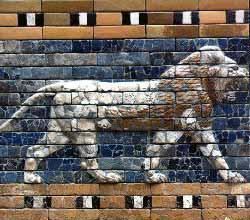 | ||
The chronology of the ancient Near East provides a framework of dates for various events, rulers and dynasties. Individual inscriptions and texts customarily record events in terms of a succession of officials or rulers, taking forms like "in the year X of king Y". Thus by piecing together many records a relative chronology is arrived at, relating dates in cities over a wide area. For the first millennium BC, the relative chronology can be tied to actual calendar years by identifying significant astronomical events. An inscription from the tenth year of Assyrian king Ashur-Dan III refers to an eclipse of the sun, and astronomical calculations among the range of possible dates identify the eclipse as having occurred 15 June 763 BCE. The date can be corroborated with other mentions of astronomical events and a secure absolute chronology established, that ties the relative chronologies into our calendar.
For the third and second millennia, the correlation is not so fixed. A key document is the Venus tablet of Ammisaduqa, preserving record of astronomical observations of Venus, as preserved in numerous cuneiform tablets during the reign of the Babylonian king Ammisaduqa, known to be the fourth ruler after Hammurabi in the relative calendar. In the series, the conjunction of the rise of Venus with the new moon provides a fixed point, or rather three fixed points, for the conjunction is a periodic occurrence. Astronomical calculation can therefore fix, for example, the first dates of the reign of Hammurabi in this manner either as 1848, 1792, or 1736 BC, depending on whether the "high" (or "long"), "middle" or "low (or short) chronology" is followed.
For the 3rd and 2nd millennia BC, the following periods can be distinguished:
- Early Bronze Age: A series of rulers and dynasties whose existence is based mostly on the Sumerian King List besides some that are attested epigraphically (e. g., En-me-barage-si). No absolute dates within a certainty better than a century can be assigned to this period.
- Middle to Late Bronze Age: Beginning with the Akkadian Empire around 2300 BC, the chronological evidence becomes internally more consistent. Essentially, for this period, a good picture can be drawn of who succeeded whom, and synchronisms between Mesopotamia, the Levant and the more robust chronology of Ancient Egypt can be established. The assignment of absolute dates is a matter of dispute; the conventional middle chronology fixes the sack of Babylon at 1595 BC while the short chronology fixes it at 1531 BC.
- The Bronze Age collapse: a "Dark Age" begins with the fall of Babylonian Dynasty III (Kassite) around 1200 BC, the invasions of the Sea Peoples and the collapse of the Hittite Empire.
- Early Iron Age: around 900 BC, historical data, written records become more numerous once more, with the rise of the Neo-Assyrian Empire, enabling the certain assignment of absolute dates. Classical sources such as the Canon of Ptolemy, the works of Berossus and the Hebrew Bible provide chronological support and synchronisms. An eclipse in 763 BC anchors the Assyrian list of imperial officials.
Variant Bronze Age chronologies
Due to the sparsity of sources throughout the "Dark Age", the history of the Near Eastern Bronze Age down to the end of the Third Babylonian Dynasty is a "floating chronology". In other words, it fits together internally as a "relative chronology" but not as an "absolute chronology".
The major schools of thought on the length of the Dark Age are separated by 56 or 64 years. This is because the key source for their dates is the Venus tablet of Ammisaduqa and the visibility of Venus has a 56/64 year cycle. More recent work by Vahe Gurzadyan has suggested that the fundamental 8-year cycle of Venus is a better metric. (see update in ) There have been other attempts to anchor the chronology using records of eclipses and other methods, but they are not yet widely supported. The alternative major chronologies are defined by the date of the 8th year of the reign of Ammisaduqa, king of Babylon. This choice then defines the reign of Hammurabi.
The middle chronology (reign of Hammurabi 1792–1750 BC) is commonly encountered in literature, and many recent textbooks on the archaeology and history of the ancient Near East continue using it. The alternative "short" (or "low") chronology is less commonly followed, and the "long" (or "high") and "ultra-short" (or "ultra-low") chronologies are clear minority views. There are also some scholars who discount the validity of the Venus tablet of Ammisaduqa entirely. Early twenty-first century dendrochronology has essentially disproved the short chronology. For much of the period in question, middle chronology dates can be calculated by adding 64 years to the corresponding short chronology date (e.g. 1728 BC in short chronology corresponds to 1792 in middle chronology).
The following table gives an overview of the competing proposals, listing some key dates and the deviation relative to the short chronology:
The chronologies of Mesopotamia, the Levant and Anatolia depend significantly on the chronology of Ancient Egypt. To the extent that there are problems in the Egyptian chronology, these issues will be inherited in chronologies based on synchronisms with Ancient Egypt.
